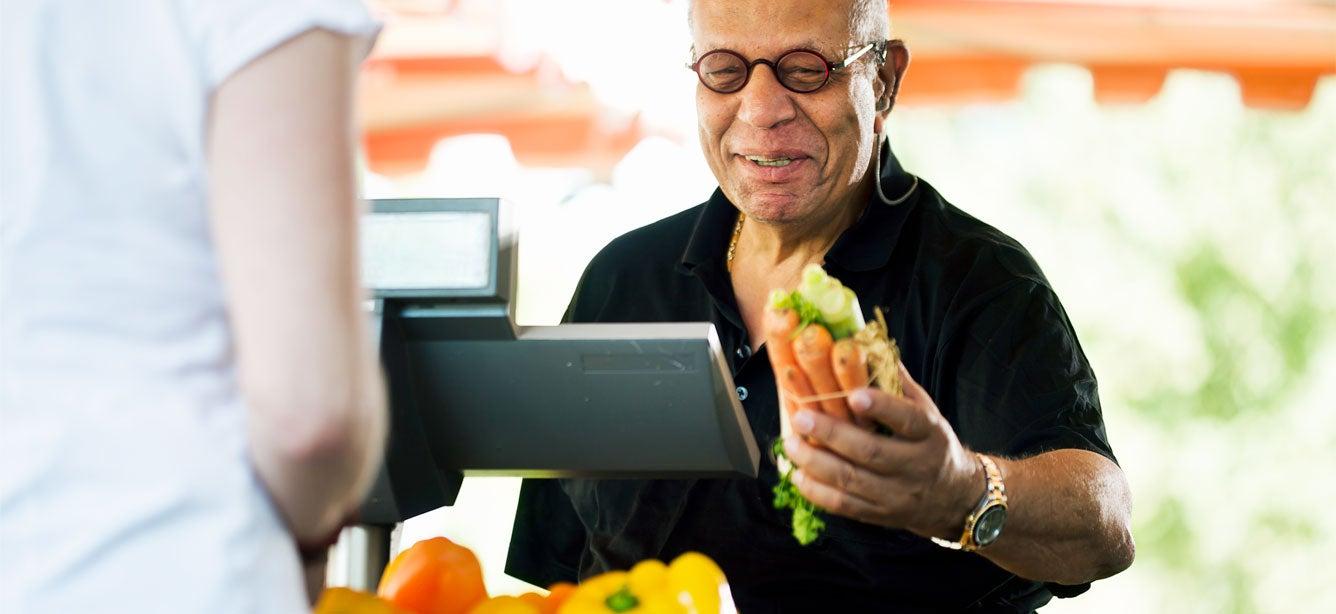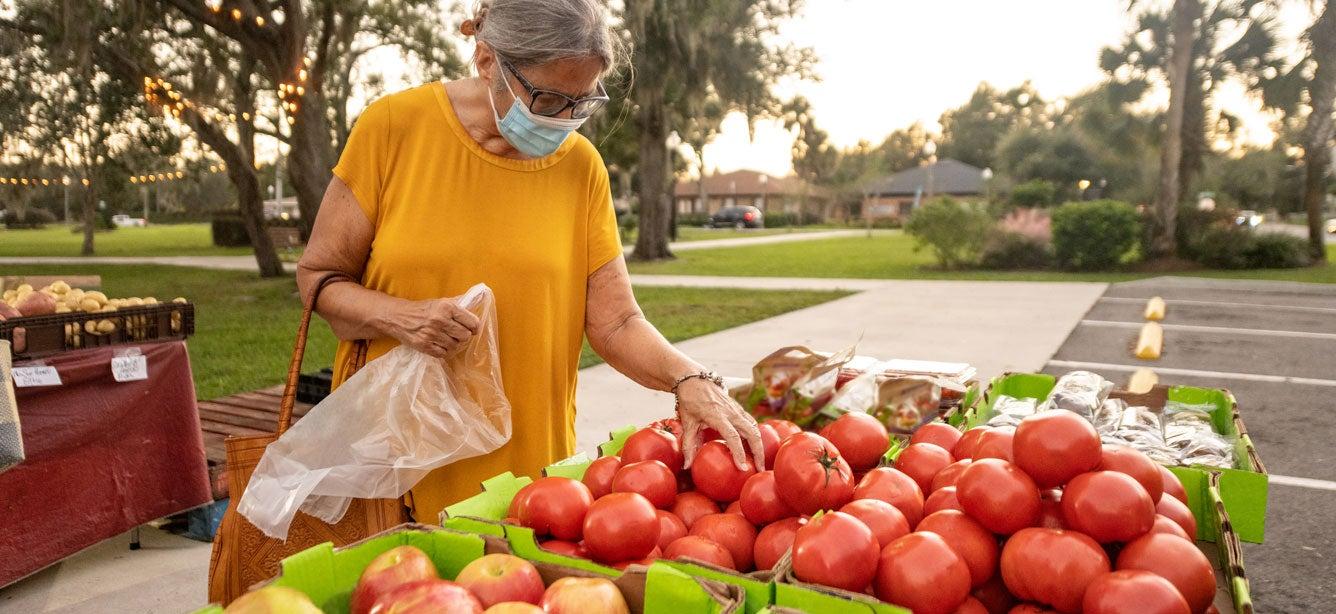
Related Topics
You may already know about the Supplemental Nutrition Assistance Program (SNAP)—an important government-funded benefit that helps income-eligible households afford the food they need to maintain good health. But have you heard about the Seniors Farmers’ Market Nutrition Program (SFMNP)? If you receive food stamps (SNAP) or participate in another means-tested assistance program, you might also qualify for SFMNP.
What is the Seniors Farmers’ Market Nutrition Program? (SFMNP)?
The SFMNP is another financial resource you can use when it’s time to replenish your fridge.
According to the most recently available data, the SFMNP helps more than 750,000 low-income older adults purchase fresh, locally grown vegetables, fruits, herbs, and honey at farmers’ markets, roadside stands, and community supported agriculture programs (CSAs) each year.1,3 Funded by the Farm Bill, this federal/state partnership provides produce vouchers and nutrition education to participating adults age 60 and over. Being in the program helps you buy healthier food and improve your diet while learning skills for selecting, storing, and preparing fresh produce. The USDA’s Food and Nutrition Service (FNS) awards grants to authorized agencies—such as State Councils on Aging or State Departments of Agriculture—who then administer all aspects of the program including how to apply for senior farmers’ market nutrition program benefits, distributing farmers’ market vouchers, enrolling local selling partners, and designing relevant educational sessions.
It's important to know that SFMNP is an optional program and not every state participates. Nor does every participating agency offer statewide access. According to the USDA's most recent information, 57 state agencies, U.S. territories, and federally recognized Indian Tribal Organizations (ITOs) received FNS grants to fund the SFMNP.1 You can use the USDA's Seniors Farmers' Market Nutrition Program (SFMNP) contact map to check availability in your area.
Is the Seniors Farmers’ Market Nutrition Program (SFMNP) the same as SNAP?
No. While both programs help eligible seniors afford healthier food, each is funded and administered separately.
Can I receive both SFMNP and SNAP assistance?
Yes. Neither program is mutually exclusive. In fact, when used together, both can help you stretch your grocery budget even further (see below for more details).
How do I qualify for the SFMNP?
Qualifying for the program is straightforward: You need to be at least 60 years old, with a household income that doesn’t exceed 185% of the federal poverty guidelines.
As of July 2025, this means you can receive $2,413 monthly (or $557 weekly) if you live in a single-person senior household in the contiguous United States.2 If you live in a two-person senior household, these monthly numbers increase to $3,261 and $753, respectively.
You may not even need to document your household income when you apply for the Senior Farmers’ Market Nutrition Program. Some state agencies will simply accept proof of participation in another means-tested program, such as SNAP or the Commodity Supplemental Food Program, to determine your eligibility.3
How do I apply for the Senior Farmers’ Market Nutrition Program?
First, you’ll need to identify the agency that administers the program in your state. You can do that by visiting the USDA’s state agency contact map.
Because the actual application process can vary, be sure to reach out directly to your local administrative office for detailed information and guidance.
How much will I get in SFMNP assistance?
If you’re eligible for the program, you’ll receive between $20 and $50 each year depending on where you live. Individual agencies may also supplement these benefits with state, local, and/or donor funds.
“Each spring, the USDA revises its income eligibility guidelines for the program and strongly encourages participating state agencies to implement those changes immediately, so that more older adults might qualify,” explained Brandy Bauer, former Director of NCOA’s MIPPA Resource Center. “However, it’s up to each agency to decide whether the actual benefit amount itself will change.”
In 2025, for example, program benefits increased to $80 for participating residents in the Tacoma, Washington area. That’s why Bauer suggests that you check with your local administrative office each season to see if there’s been a bump.
"Twenty or even $50 dollars may not sound like much," Bauer said. "But buying your produce directly from the farmers who grow it can be a lot less expensive than what you’d pay at the grocery store." And if you combine your SFMNP assistance with SNAP benefits at the farmer’s market, you can get even more for your money. (More on this below).
How does the SFMNP work?
For consumers, the process is streamlined and simple.
Each state agency issues benefits in the form of farmers’ market vouchers (sometimes, these are Electronic Benefits Transfer, or EBT, cards) which you can then use to buy your produce. Once redeemed, authorized farmers, farmers’ markets, CSAs, and roadside stand operators submit these vouchers to the appropriate agency for reimbursement.
Can I use both SFMNP and SNAP at farmers’ markets?
Absolutely. And it can be a great strategy to pair them up.
First, while you may only use Senior Farmers’ Market Nutrition Program dollars for veggies, fruits, herbs, and honey, you can use your SNAP benefits for a broader list of items—including meat, poultry, dairy, eggs, bread, and more. Together, both programs can help fill your farmers’ market basket with a well-rounded selection of groceries. This helps your health, and the health of your local economy, too.
“It’s a win-win situation all around," says Gretchen Dueñas-Tanbonliong, Associate Director for Health and Wellness at NCOA and a registered dietitian nutritionist. "Not only do you support farmers by buying locally grown foods, but you also get to eat nutrient-dense seasonal produce at the peak of its flavor and help keep the environment healthy because there’s less water, land use, and pollution involved.”
Second, thanks to the Double Up Food Bucks program, your SNAP dollars wield twice the purchasing power at participating farmers’ markets (and other eligible retailers) when you use your benefits card to buy fresh fruits and vegetables. Check with your farmers’ market manager for details and assistance on how to make this happen.
Tom, 60 years old, recently learned about Double Up Food Bucks in Colorado.
After qualifying for SNAP benefits, he was excited about what he could buy. “Not only can I shop for the healthy food I want, but I also can use SNAP at my local farmers’ market,” he says. And, thanks to Double Up Food Bucks, he can even afford locally grown cantaloupe, too.
Double Up Food is currently available in more than 25 states, and you’re automatically eligible if you receive SNAP benefits.4
What percentage of the Seniors Farmers’ Market Nutrition Program cost is supported by federal funds?
The 2002 Farm Bill permanently authorized the SFMNP and fully funded its costs through 2007.5 In the time since, various extensions to the bill have continued this funding. However, with a December 2025 expiration date now looming as part of the 2018 Farm Bill, federal funding likely will change in 2026. In that case, individual states will need to step in to cover program costs and continue coverage.
While the vast majority of FNS grant money passes through state agencies to provide direct benefits to seniors, individual partners are allowed to spend up to 10% of grant funding on administrative costs. If you’re an eligible senior, you’ll receive famers’ market vouchers and nutrition education at no cost to you.
Additional resources to help pay for food
Eating well is essential for good health as we age—yet it can be difficult to afford healthy food on a fixed income. BenefitsCheckup.org, a free service offered by the National Council on Aging, matches your unique needs to relevant benefit programs, current eligibility requirements, and application information using a simple online screening tool. Learn more about nutrition and other financial assistance programs that can help you maintain good health and economic security now, and into the future.
Sources
1. USDA Food and Nutrition Service. Senior Farmers Market Nutrition Program. Updated September 8, 2025. Found on the internet at https://www.fns.usda.gov/sfmnp/senior-farmers-market-nutrition-program
2. USDA Food and Nutrition Service. SFMNP Income Eligibility Guidelines (2025-2026). Found on the internet at https://fns-prod.azureedge.us/sites/default/files/resource-files/sfmnp-iegs-2025-26.pdf#page=2
3. USDA Food and Nutrition Service’s “Seniors Farmers’ Market Nutrition Program Fact Sheet”. Found on the internet at https://www.fns.usda.gov/sfmnp/fact-sheet
4. Fair Food Network. Get Double the Fruits & Veggies. Found on the internet at https://doubleupamerica.org/
5. National Sustainable Agriculture Coalition. Senior Farmers Market Nutrition Program. Found on the internet at https://sustainableagriculture.net/publications/grassrootsguide/local-food-systems-rural-development/farmers-market-nutrition-program/



